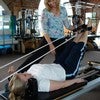Description
About This Video
Transcript
Read Full Transcript
Hi, I'm Madeline black and you may have a few challenges or restrictions when you go to a mat class. And I'm here to show you a few tips to make your mat class more enjoyable and to encourage you to take a class you might feel a little tentative about taking because maybe you can't get onto the floor and get up well, or maybe you have a problems lying on your back. [inaudible] Mat classes primarily are lying on the floor. So we have to get down to the floor, you have to get up, you have to lie on your backs and we need some arms and leg strength in order to do these movements. So I'm going to show you a few modifications so that when you walk into your next math class, you'll be more comfortable and feel safe and progress better in your strength.
Right? So here's Mandy and she's here to model for us. So first thing is if you have trouble getting onto the floor and getting back up, I suggest that you take your mat and put it near a wall in the class. So we're gonna use this table and imagine that it's a wall. So you would lean your hand on the wall and you want to step forward with the leg that's away from the wall. So you step forward and bend the knee, use the waffle support and go down. And then you're going to place your hands on the floor and come onto both knees.
Great. So now in a quadro head head position, and then you're going to go down with your hip and then onto your elbow. I call this the baby. Go, go get right. And lying. Rolling onto the back. So let's, um, let's get, um, I want to show the little baby get up position. So first I'm roll towards the camera though. So should they can just say, so you're gonna roll to the side and pause here so that you have the one arm ready on the floor here and the leg here. This is that position like a baby on the floor, but you have to do it towards the wall. So come on your back Mandy, and you're going to roll towards the wall now into that baby.
Get up position, and then you're going to use your arms and push onto your knees again. Great. And then you're going to step forward with one foot. Put one hand up onto the wall so that you can step forward. Now here's an important little note. Tuck your toe under underneath here, because you're gonna use not only the wall, but your back foot to push up to stand up. So let's see it one more time. Okay, so using the wall, she steps forward, bends down, reaches towards the floor, gets on both knees, and then it's going to be hip down to the forearm. There's that baby.
Get up position and rolling onto the back. And then to get up, you roll back. We're just doing a reversal into the baby. Get up position onto four your hands and your knees, and then you're going to lean for the wall and step forward with your leg. Tuck those toes underneath and push up to stand up. Perfect. Okay. Now for those of you who have difficulty lying on your back, there may be many reasons for that. Your head is a little forward or your back's a little rounded, maybe have trouble breathing.
So in some studios there are a lot of props and if you're taking a class where there aren't, then bring your own props. So I suggest first off a wedge pillow. So if you can get an inexpensive wedge pillow here and when you lie and then lie down, you will feel supported on the mat with your head up slightly and you'll be able to breathe a little bit better. All right, now if your legs are a really heavy or long or you have difficulty holding your legs up, people have a hard time holding legs up for a long period of time. And employees, we do a lot of things where our legs are up. So if you can get a smaller physio ball and then we can bring it under your legs and you can rest the legs on the ball in this position.
And then from this position you can do your mat work, you can do the arm movement or the hundreds, right? And reaching long. This way you can do like a double leg stretch. So if the feet are here, just stretching out and in so that the weight of your legs, uh, is resting on the ball. It's also good for those who, who tend to have a lot of hip flexion flexor tension here. It helps relieve that with the support of the ball. Okay. And now let's say that I'm going to give you another option, which is actually very challenging for the abdominals if you don't have a wedge pillow. So we're going to take that away. And another option is to get a medium size ball. And again, a lot of studios have a whole variety of balls these days.
So what we can do is um, take the pillow away and place the ball on the broad line. So come on back and hold your head. Support your head here. So in this position you can keep this supported the ball. And then again you can do things like legs, slides, or knee folds. This kind of action that we do in pilates mat classes, you can bring up one leg, slide this one down.
Any kind of a motion that we do in the Palladia smack class. Now this is more challenging because the ball does move a little bit. So you're going to have to work. But it is a really nice tool to keep your back supported and your head up a little bit more. Okay and come up. And so for arm strength, uh, we want to be able to push ourselves up, especially if we're going down to the floor and coming up. And as we get older, it's actually really important to have arm strength so that in case you fall down, you're able to come up and push with your arms.
So I'm going to recommend that you do like wall planks and little wall pushups. So let's go over to the wall. Okay, so we're at the wall and you'd look in a very simply place your hands on the wall and one little point or for your wrist. It's just make sure that your risk line is straight across this way. So that's approximately where your second finger is pointing straight up and elbow, slightly facing other, just a tiny little turn inward. And then you can be vertical or slightly on an angle like Mandy is, and just simply bend your elbows slightly and push away from the wall and keeping your head in alignment.
And you can just repeat that until you feel a little tired, maybe 10 times, maybe 15 times. And then take a rest. If you can do 15 then you need to challenge yourself a little bit more by being further on an angle so you can walk back away from the wall and do it here. Or if you have a countertop at home, for instance, let's go back to the table. So if you have a countertop, you can actually get your body in a different angle. So walking the legs back and then again bending and you don't have to go deep.
The idea is to try to keep your body alignment, your let your neck in line with your spine. And when you're bending the elbows you don't want to lose your shoulder blades here so you keep the shoulders nice and strong. The shoulder blades on the back so it can be a small bend and repeat. And then as you get stronger, you can take it up into more of a traditional plank. And I like to start with the knees bent.
So you're still in a quad quadriped position and the pelvis is going to come forward though. So you're going to be in a plank, but the knees are bent. That's it. And you can cross your ankles if you'd like. That's it. And then again, you want to make sure your head is the best as it can be in line with your spine. And then you can bend the elbows here and push up. And you can do as many, even if you can only do two or three, it's a good start. You just take a rest and repeat again. Right?
So developing arm strength is important over time and that will help you in your math classes. Because we do arm supports in Mat class. There's a front support back support and a and a one arm side support. So to start developing a little bit of strength, we will make your math classes a little more enjoyable and you'll start to progress and become stronger.
Comments
You need to be a subscriber to post a comment.
Please Log In or Create an Account to start your free trial.
















